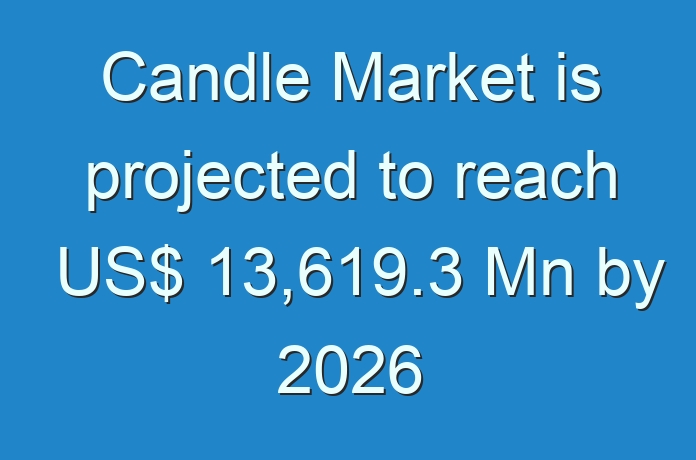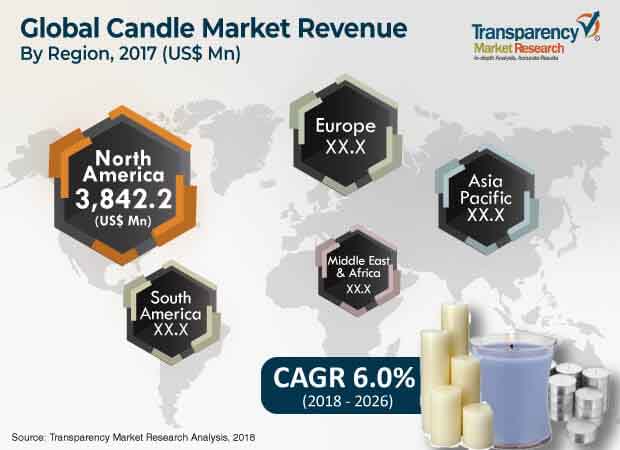
A candle is an ignitable wick made of wax which provides light. Initially, candles were a functional product and only used as a source of light. In the modern world, candles are a symbol of celebration; it signifies aroma; defines a ceremony and events; soothes the senses etc. Manufacturers are innovating candles and offering aromatic candles for the living room, and dim light candles for the bedroom etc. Candles are available in various sizes, shapes, designs, and colors which includes tea lights, votive, pillars, birthday candles, cartridge candles, wax filled container candles, and others. Candles are manufactured from different kind of waxes such as beeswax, stearin, paraffin wax, rapeseed wax, palm wax, soy wax, and others. Paraffin wax is the most common raw material used in the production of candles. Candles made of organic wax are an alternative to paraffin wax candles. The global candle market is estimated to reach a value of US$13,619.3 Mn by 2026.

Key factors driving the candle market includes increase in usage of candles for special occasions such as birthdays or marriage ceremonies, events, festivals etc. Furthermore, rise in usage of candles by therapists to create a peaceful ambiance in therapy rooms, lighting candles during prayers and for meditation etc. are some of the key factors fueling the growth of the candle market. Evolution in e-commerce has created huge opportunities for manufacturers and suppliers across the globe. In order to cater to a comprehensive range of customers across the world, manufacturers and suppliers of candles are focusing on selling their products on various e-commerce websites.
Rise in popularity of scented candles and wax filled container candles is expected to trigger the growth of the candle market during the forecast period. However, a major challenge restricting the growth of the candle market is volatility in the prices of raw materials. Availability of various substitute products such as electric candles, fairy lights etc. is anticipated to hamper the growth of the candle market.
The usage of natural wax in the production of candles takes the product to a different level. The usage of natural wax is projected to continue to expand in the coming years. It includes products such as beeswax, soy based wax, and rapeseed wax. Consumers prefer a calm flame candle which leaves minimum wax. A candle which does not lead to carbon blackening in the home is preferred so that it does not have to be cleaned. Candle manufacturers are designing customized candles to cater to the different needs of customers. Scent infused candles are mostly preferred due to their added characteristic to lighten the mood. Aromatherapy treatment also employs scented candles which help to release mental and physical stress. The market for aromatherapy has grown rapidly, which has increased the consumption of aromatic candles. Manufacturers have also launched mosquito repellent candles which offer protection from mosquitoes. Citronella oil, a pure plant based derived oil is added to wax candles. Mosquito repellent candles are organic and give out a pleasant scent while burning and does not produce any toxic or harmful fumes. This is expected to augment the demand for candles from 2018 to 2026.
Ask for brochure:
https://www.transparencymarketresearch.com/sample/sample.php?flag=B&rep_id=50343
Some of the prominent players operating in the global candle market include Vollmar GmbH, Baltic Candles Ltd, Bolsius International BV, Delsbo Candle AB, Duni AB, Hansa Candle AS, KORONA Candles S.A., Ceras Roura, Contract Candles Ltd, and Candle Scandinavia Group AB etc. These players are estimated to face tough competition in the near future due to presence of a large number of local players in the market. Major brands are likely to focus on innovation and research & development activities to strengthen their foothold in the global candle market. Companies are undertaking mergers and acquisitions, and joint ventures with local players to expand their product portfolio. Manufacturers in developing countries are focusing on reducing their cost of production and increase profitability for the sustainable growth of their business.
Read Our Latest Press Release:





